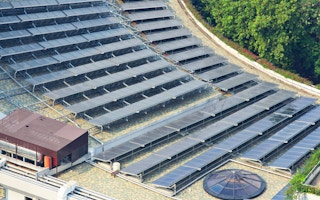The solar industry is facing a looming shortage of photovoltaic panels, reversing a two-year slump triggered by a global glut.
The oversupply pushed prices through the floor, making solar power more competitive and driving up demand. It also dragged dozens of manufacturers into bankruptcy, and slowed capital investment at the survivors. With installations expected to swell as much as 29 per cent this year, executives are bracing for the first shortfall since 2006.
Scarcity will benefit the biggest manufacturers, including China’s Yingli Green Energy Holdings Co and Trina Solar Ltd. A shortage may slow development outside the top markets in Asia and North America if suppliers favor their largest customers. Shipments to large, utility-scale solar farms may get priority over smaller, rooftop systems, threatening one of the industry’s fastest-growing markets.
“The cell and module glut has certainly dried up,” said Stefan de Haan, a solar analyst at IHS Inc. “There is no massive overcapacity anymore.”
Related: Obama’s Green Dilemma: Punish China, Imperil US Solar
The looming shortage shows the rapid expansion of solar energy. The industry may install as much as 52 gigawatts this year and 61 gigawatts in 2015. That’s up from 40 gigawatts in 2013, and more than seven times what developers demanded five years ago, according to Bloomberg New Energy Finance.
“
According to our estimation, the gap between supply and demand will be closed at the end of 2014. This will definitely lead to rising investments in advanced equipment
Axel Bartmann, spokesman for Manz AG
The industry has about 70 gigawatts of production capacity, New Energy Finance estimates, including a significant amount of older equipment that’s not profitable. The supply-demand balance is tighter than those numbers suggest. De Haan estimates capacity at about 59 gigawatts, excluding manufacturing lines that are out of date or obsolete.
‘On par’
Considering only “factories that are meaningful and active,” supply and demand is “almost on par,” said Luc Grare, senior vice president for the Norwegian panelmaker REC Solar ASA.
The last time supplies were hard to find was in 2006, when the nascent industry installed just 1.5 gigawatts of capacity. The following year, the top Chinese manufacturers raised $1.8 billion selling stock to Wall Street to finance new production capacity.
Chinese manufacturers sold about $5 billion of shares from 2005 to 2010, and wrested control of the market from companies in the US, Germany and Japan. The added capacity drove down prices and pushed dozens of manufacturers into bankruptcy. Solar panels sell for 76 cents a watt now, compared with $2.01 at the end of 2010. The price has slipped 12 per cent this year.
Expanding now
Nobody is predicting upheaval now. Production capacity this year is “expected to stay more or less flat, but consolidate, with new-build balancing exits,” said Jenny Chase, lead solar analyst at New Energy Finance.
Some manufacturers are already expanding. In May, Canadian Solar Inc began construction on a new cell factory in China, a joint venture with GCL-Poly Energy Holdings Ltd that will initially have 300 megawatts of annual capacity.
The solar industry is cyclical and near a turning point, said Canadian Solar Chief Executive Officer Shawn Qu. He’s expanding now because he anticipates a shortage.
“Every industry goes through cycles,” Qu said. “It’s inevitable to see a cycle in solar.”
Other manufacturers already see a shortfall.
“It would be fair to say our panels are in short supply,” said Tom Werner, CEO of SunPower Corp. The San Jose, California-based company’s factories are running at full, and it announced in July plans for a new factory that may begin production in 2017 and will be able to make at least 700 megawatts a year. That’s more than double the plant it’s bringing online next year.
Supply chain
When panels become scarce, they’ll probably be routed to customers placing the biggest orders, said Angelo Zino, an analyst in New York at S&P Capital IQ.
“The large-scale utility projects are going to be where the modules go,” Zino said. “If there’s any sort of tightness in the supply chain, you would think that the push-outs would be on the residential side.”
That potential threat to the rapidly growing US residential solar market prompted SolarCity Corp to buy a panelmaker in June. The rooftop developer expects demand to surge, especially for systems atop homes and commercial buildings.
SolarCity deal
“At some point, it will be a 400-gigawatt-a-year market; it’s just mathematical,” said CEO Lyndon Rive. Smaller companies without supply contracts may be unable to get enough panels.
Billionaire Elon Musk, SolarCity’s chairman, said the acquisition will guarantee supply. “If we don’t do this, we thought there was risk of not being able to have the solar panels we need,” he said during a conference call announcing the deal.
Any shortage may also limit deliveries to markets where stronger demand means better pricing, said REC Solar’s Grare.
Regions with “heavy price competition” such as Latin America will feel a shortage first, while regions with stable prices, such as the US and Japan, will be prioritised, he said.
Companies that make manufacturing equipment such as Germany’s Manz AG expect the looming shortage to spur orders.
“According to our estimation, the gap between supply and demand will be closed at the end of 2014,” said Axel Bartmann, a spokesman for Manz. “This will definitely lead to rising investments in advanced equipment.”
Panel pricing
Unlike other industries, a shortage probably won’t boost prices, said Arno Harris, CEO of Recurrent Energy, a San Francisco-based developer owned by Sharp Corp.
As production costs slide, manufacturers can increase profit without raising prices. That’s important because solar power is extremely price-sensitive, Harris said.
“It would be difficult for module pricing to really go up because there isn’t going to be natural demand for those products at those higher price points,” Harris said. “If you raise the price too much they’ll move on to something else. They’ll move on to gas, they’ll move on to wind.”










